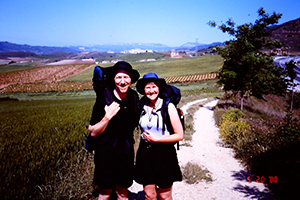 Walking Distance, a Camino memoir
Walking Distance, a Camino memoir
David Hlavsa heads the Theatre Arts Department at St Martin’s University in Lacey, Washington. His Camino memoir Walking Distance: Pilgrimage, Parenthood, Grief and Home Repairs remembers his trip to Santiago de Compostela with wife Lisa. Here’s an excerpt from his book:
Walking Distance: Pilgrimage, Parenthood, Grief, and Home Repairs by David Hlavsa
On pilgrimage, there is a constant sense of the body in motion, therefore in space, and of the space above and below. For those of us accustomed to spending most of our days indoors, earth and sky regain their significance, and we float free between them. Books, possessions of all kinds, are leaden things, distractions, anchors.
Fields of spring wild flowers drift by, poppies by the side of the path, huge purple thistles, sunflowers, gnarled grapevines, olive trees, cowpastures. Ruined castles on the hills. On the high ridges, in the land of Don Quixote, massive wind turbines whoosh and hum. Medieval towns rise in the distance, islands from a seaof cropland.
As we approach a town, there is none of the ill-defined transition from country toexurb to suburb to city that has become the norm in the States. The town looms larger, larger,and then we simply arrive, step from fields to town, as we might from a boat to a dock and comeupon, in medias res, the life of an insular community.

The entire length of the Camino is impossibly layered with history, myth, legend, rumor, literary reference, local tradition and religious anecdote. Story upon story in an absurd, indigestible Dagwood sandwich of narrative. Our guidebook attempts bite-sized summaries. At first, I try to keep track of it all, reading aloud to Lisa with all the reverence I can muster. Each time we pause to rest at some landmark, I once again whip out the guidebook. Ignoring my fellow traveler’s sour expression, I press on valiantly; but I soon find it’s impossible to keep a note of helium-high hysteria from creeping into my voice. This rock is famous for being the same length as the stride of the great Roland. After fighting off the Saracens, Charlemagne napped here. This is the very street where El Cid did his El Cid thing. This lovely little church is yet another example of late Gothic construction with Moorish influences – another gem of the Camino.

Over the side goes the guidebook.

Pictured: David and Lisa during their Camino de Santiago trip back in 2000 and David and Lisa with their son Ben, today.
For more information about the Camino de Santiago routes or to book your Camino trip, contact our travel specialists

 Walking Distance, a Camino memoir
Walking Distance, a Camino memoir